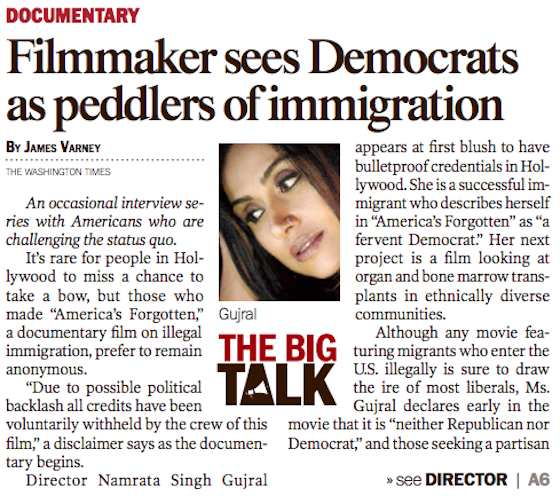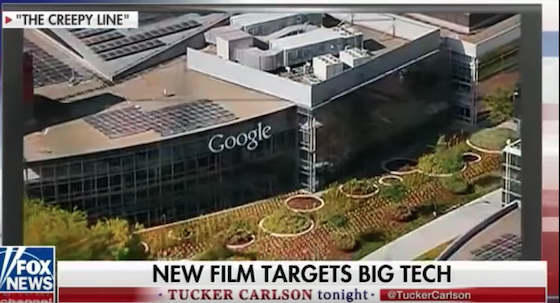Her film got a front-page treatment from the Washington Times, with an article titled ‘America’s Forgotten’: Democrat director discovers horrors of illegal immigration while making [...]]]>
Her film got a front-page treatment from the Washington Times, with an article titled ‘America’s Forgotten’: Democrat director discovers horrors of illegal immigration while making film.

A Breitbart piece included a short clip from the documentary with a smuggler hawking America’s available free stuff to potential customers: Watch: Documentary Shows Coyotes Using Democrat Debate Footage to Recruit Illegal Border Crossers
Gujral started her film with the intention that it was going to be pro-illegal alien, but the specifics of several cases convinced her that too much suffering and death was the real result — both from disastrous illegal border crossings and preventable crimes of unlawful aliens.
Following is the film trailer:
An interview with Elizabeth MacDonald on Fox Business provided more detail, where Gujral noted, “Most of the people that are coming in are coming in for what we call in the film a ‘lifestyle upgrade’ — a lot of them spending $75,000 per person, $50,000 per person — these are not people that are poor.”
The film is available for streaming at AmericasForgottenMovie.com
]]>In one segment of Friday’s show, Tucker interviewed Peter Schweizer, who has a new documentary coming out in September titled The Creepy Line (an odd title explained below). Here’s the trailer:
An eye-opening documentary, The Creepy Line reveals the stunning degree to which society is manipulated by Google and Facebook and blows the lid off the remarkably subtle – hence powerful – manner in which they do it.
The Creepy Line is a title taken from the words of former Google CEO Eric Schmidt, when during a 2010 interview he explained Google’s code of conduct: “The Google policy on a lot of things is to get right up to the creepy line and not cross it.”
However, as Dr. Robert Epstein explains in the film, “Google crosses the creepy line every day.” Containing interviews with Jordan B. Peterson, Peter Schweizer, and others, The Creepy Line offers an explosive look at the meddling and intervening done by Google and Facebook on their supposedly “neutral platforms.”
The Creepy Line takes the conversation about data privacy and control further than ever before by examining what Google and Facebook do once they control a user’s data. Offering first-hand accounts, scientific experiments and detailed analysis, The Creepy Line examines what is at risk when these two tech titans have free reign to utilize the public’s most private and personal data.

Here’s the Tucker Carlson Tonight segment discussing the film:
]]>A rare expression of this wrenching culture clash is a short film created by Sanjay Patel telling his own childhood struggle to fit in. As a boy, Sanjay felt “embarrassed and mortified by how different my family was” and producing the film brought up many of the issues all young immigrants face about assimilation. Here’s a snip of the film, Sanjay’s Super Team:
Now 41, Patel sounds well adjusted and he certainly is successful to have Pixar produce his film as an opener for the feature “The Good Dinosaur.” Monday’s San Jose Mercury celebrated his success with a front-page story, noting the Oakland-residing filmmaker’s work has been nominated for an Oscar.

Patel’s apparent assimilation is all the more admirable because India’s traditional culture is hardly acceptable by the standard of American values. In my 2007 Vdare article, “Dogs, Frogs and Dalits — the Indian Model Minority Has a Dark Side”, I outlined the objectionable items of caste (from light-skinned Brahmins to darker untouchables), dowry murder, widespread sex-selection abortion (against females of course), child labor, slavery and belief in witchcraft. Also included was the case of immigrant Lakireddy Bali Reddy, convicted of human trafficking connected with the death of a teenaged girl he bought in his hometown who died from carbon monoxide poisoning from a faulty heater in Berkeley.
Back to the present: Sanjay’s Super Team looks to be a good bet for an Oscar because of the ongoing race kerfuffle within the Academy, despite Pixar’s denial of having a “diversity agenda.”
]]>Oscars 2016: ‘Sanjay’s Super Team’ creator finally feels comfortable in his own skin, San Jose Mercury News, February 21, 2016
When Sanjay Patel was a boy, he and his dad had a ritual every morning and evening. They sat side by side on the floor of the motel the family ran in San Bernardino. The father prayed to his gods in his daily meditation. The son often worshipped his own gods, cartoon superheroes, in front of his own shrine, the television.
Patel, a longtime animator at Pixar Studios who lives in Oakland, tapped into that childhood memory for his Oscar-nominated animated short film “Sanjay’s Super Team.” He’s spent a lifetime trying to bridge the gap between his American attitude and his cultural roots and parents’ Hindu traditions.
“I was always embarrassed and mortified by how different my family was,” says Patel, 41, who has worked on animated hits such as “A Bug’s Life,” “Toy Story 3,” “Monsters, Inc.” and “The Incredibles.” “It took me a long time to feel comfortable in my skin.”
Amid the discontent over the all-white roster of acting nominees for this year’s Oscar, “Sanjay’s Super Team,” a seven-minute short that played in theaters before “The Good Dinosaur,” comes as a relief for those who wish Hollywood reflected the diversity of America today. Critics have been raving about the raw emotional power of the autobiographical film as well as its animated flash. Patel’s honesty about his childhood struggles gives this “Super Team” its special powers.
“ ‘Sanjay’ will go down as one of the studio’s best,” wrote Wired magazine, hailing it as “Pixar’s most achingly personal film.”
Indeed, this movie marks a milestone for Pixar, which has never before had a movie directed by someone of Indian descent.
“Pixar certainly didn’t greenlight the film out of some diversity agenda,” says “Sanjay” producer Nicole Grindle, “but we think it is very important to seek out and tell new stories. This is wonderful story.”
In the cheeky film, little Sanjay just can’t wrap his mind around the point of meditation. In fact, he’s bored stiff by sitting still, so he begins to dream of an epic superhero battle, only the warriors are not Batman or Wonder Woman but instead Vishnu, Hanuman and Durga, three formidable Hindu deities. These ancient gods became the ultimate “Super Team.” It’s a whimsical and sweet mashup of the sacred and the pixelated that eventually creates a bridge between father and son.
“I lost a lot of sleep over that. How can you sum up 3,000 years of philosophy in five minutes of animation?” Patel says. “I was scared to put that part of my culture and identity on display out there. The team at Pixar really helped with that, and now I couldn’t be more proud.”
Making the film has been a therapeutic experience for him, a way to heal the scars of the past, as well as honor his parents and their struggles to stay tethered to their culture. He now also confesses to stealing the gifts his father left on the shrine when no one was looking.
“In a way I think the gods got their revenge on me,” says Patel, who has also published children’s books mining the Hindu mythology, such as “The Little Book of Hindu Deities.” “As a child I thought they meant nothing to me, and now they have become a huge part of my life and my work.”
Patel remembers all too well how alienated he felt as a child growing up in the ’80s, when the television he revered never showed him faces that looked like his own. Like many children of immigrants, he was walking a tightrope between trying to respect his heritage and trying desperately to fit in with his peers.
“I would have felt less afraid if I had been able to see characters who were South Asian out there,” he explains. “It felt scary to be who I am, to be brown, and there was no way of hiding it.”
That’s part of the reason he wanted to make this film — so that the next generation feels included in the mainstream of American culture.
“What I really wanted to do was normalize this experience,” he says. “I wanted to create something my nieces and nephews could be proud of. The message is it’s OK to be you. You don’t have to be exotic; you can just be authentic to yourself.”
But Patel is most proud of the reaction of one viewer in particular, his usually reserved father, who loved the movie so much he teared up.
As it happens, Patel’s breakthrough comes at a time when Indian-Americans have at long last begun to emerge in pop culture, from Mindy Kaling and Aziz Ansari to “Silicon Valley” star Kumail Nanjiani.
“I’m so excited by what I see starting to happen out there,” Patel says. “Part of what I wanted to do with this movie was show the decision-makers that there is a hunger for these stories.”